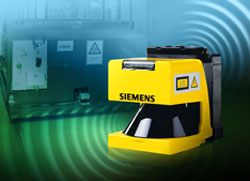New laser scanners safeguard small protection zones and transfer carriages

Typical applications for the Simatic FS660 SR include low-speed driverless transport systems of up to two meters with a short braking path.
In fixed installations, the device, which is equipped with horizontal and vertical protection, is particularly suitable for access protection at low openings, e.g. at robot cells or to protect the area around cutters and presses. The new scanner has a 190 degree field of operation, four programmable and switchable protection zones and one invisible infrared laser (Laser Protection Class 1).
In addition to the standard safety functions for personnel protection, the new Simatic FS670 laser scanner for motion monitoring reliably calculates positioning distances and speeds. It monitors as many as six different speeds and, if necessary, automatically corrects the selected protection zone.
This eliminates the need for additional incremental encoders for “speed-dependent protection zone monitoring”. This function is performed jointly by laser scanners and standard controllers. The new unit has eight programmable and switchable protection zones with ranges of between 2.15 and 4 meters (ranges of up to 6 meters will be available soon). The resolution can be adjusted from 30 to 150 mm. The protection zones are calculated automatically by the LS4Soft software.
Both scanners are certified according to Type 3 as per IEC/EN 61496-1 and -3, SIL 2 as per IEC 61508 and PL d as per EN ISO 13849. They are parameterized using the LS4Soft software.
Media Contact
More Information:
http://www.siemens.com/simatic-sensors/fsAll latest news from the category: Machine Engineering
Machine engineering is one of Germany’s key industries. The importance of this segment has led to the creation of new university degree programs in fields such as production and logistics, process engineering, vehicle/automotive engineering, production engineering and aerospace engineering among others.
innovations-report offers informative reports and articles covering technologies such as automation, motion, power train, energy, conveyor, plastics, lightweight construction, logistics/warehousing, measurement systems, machine tools and control engineering.
Newest articles

A universal framework for spatial biology
SpatialData is a freely accessible tool to unify and integrate data from different omics technologies accounting for spatial information, which can provide holistic insights into health and disease. Biological processes…

How complex biological processes arise
A $20 million grant from the U.S. National Science Foundation (NSF) will support the establishment and operation of the National Synthesis Center for Emergence in the Molecular and Cellular Sciences (NCEMS) at…

Airborne single-photon lidar system achieves high-resolution 3D imaging
Compact, low-power system opens doors for photon-efficient drone and satellite-based environmental monitoring and mapping. Researchers have developed a compact and lightweight single-photon airborne lidar system that can acquire high-resolution 3D…





















